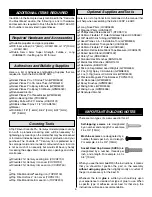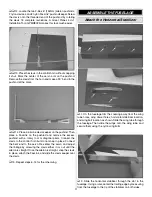
10
❏
❏
4. Using a 1/16" [1.5mm] drill bit, drill a hole through
the blocks at the locations you just marked. Tap the hole by
screwing the servo mounting screws that came with your
servo into the holes and then removing them. Harden the
threads in the block by adding two drops of thin CA glue into
each hole. Set the blocks aside and allow the CA glue time
to cure. Using the hardware supplied with the servo, mount
the servo to the blocks.
❏
5. Repeat steps 3 and 4 for the other aileron servo and
mounting blocks.
❏
❏
6. Mix together a small amount of 6 minute epoxy.
Place some of the epoxy on the wood blocks, being careful
not to get any epoxy on the servo. Place the hatch on a level
surface and place the blocks and servo on the hatch. Make
certain that the servo arm sits in the center of the opening
in the hatch. Use weight or a clamp to hold the blocks to the
hatch while the epoxy cures. Repeat this step for the other
aileron servo and hatch.
❏
❏
7. Using the radio and receiver, center the servo and
attach the control horn as shown. If any other arms are
present on the servo, remove them with a rotary tool or a
pair of diagonal pliers. Enlarge the last hole on the servo arm
using a 5/64" [2mm] drill bit.
❏
❏
8. Mount the servo hatch to the wing using the #2 x 3/8"
[10mm] sheet metal screws and #2 washers.
❏
❏
9. Hold a straight edge fl ush with the servo arm and
mark a straight line on the aileron. This is the mounting
location of the aileron control horn.
MOUNT THE HORN ALL THE WAY FORWARD
❏
❏
10. Place the aileron control horn on the aileron, centering
it on the mark you made in step 15. Use a T-pin to mark the
center of the holes. Use a 1/16" [1.5mm] drill bit to drill into
the aileron at the markings you just made, being careful not
to drill all the way through the aileron. Remove the mark you
made on the aileron using some denatured alcohol.
❏
❏
11. Use two #2 x 3/8" [10mm] sheet metal screws to
attach the control horn to the aileron. Remove the control
horn and place 2 drops of thin CA in each hole. Wipe any
excess CA from the aileron. Allow the glue to dry and reattach
the control horn to the aileron.











































